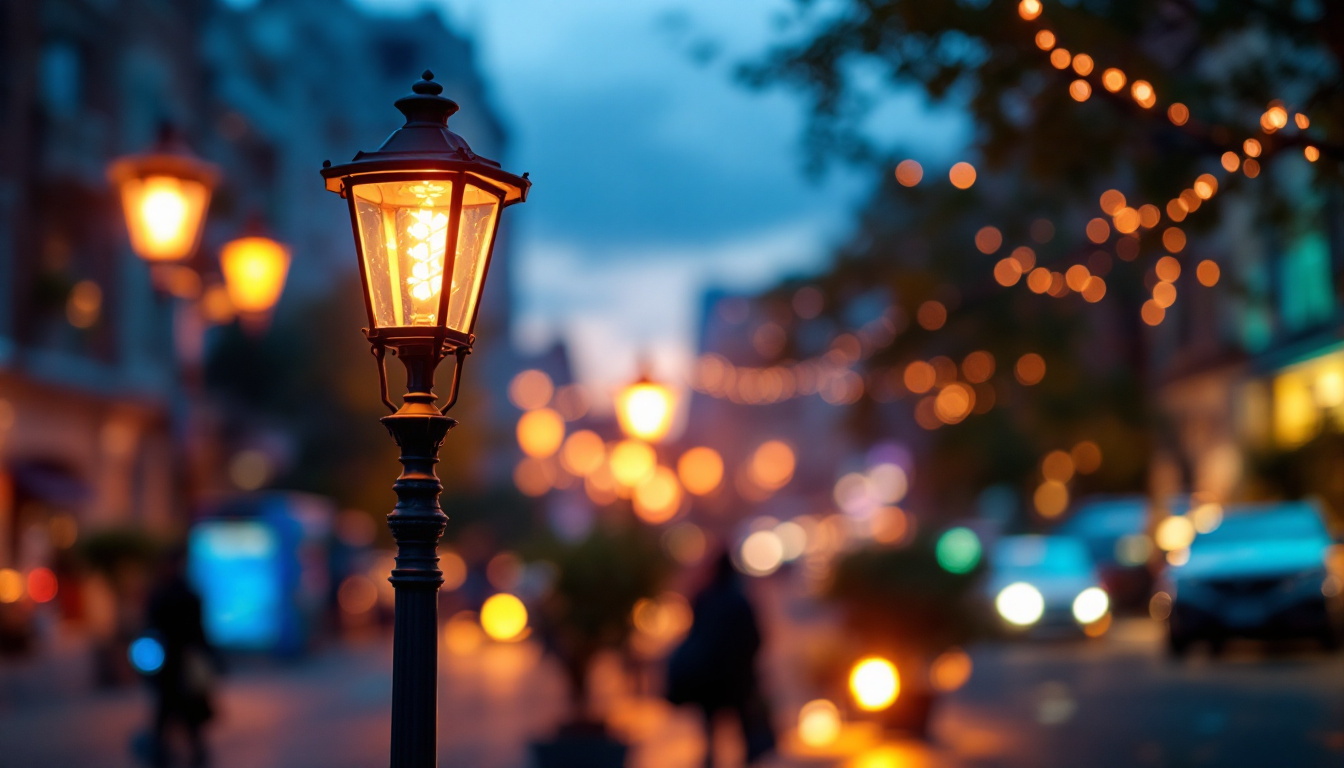
lighting professionals play a crucial role in enhancing the safety, aesthetics, and functionality of urban environments. Among the various fixtures available, lamp street lights stand out as essential components in any city’s lighting strategy. This article provides a comprehensive checklist for lighting professionals to ensure that they consider all aspects when selecting, installing, and maintaining lamp street lights.
Before diving into the checklist, it is vital to understand what lamp street lights are and their significance in urban planning. These fixtures are designed to illuminate streets, sidewalks, and public spaces, promoting safety and visibility during nighttime hours. They come in various designs, sizes, and technologies, making them suitable for different applications. The evolution of street lighting has also mirrored advancements in technology, leading to the development of smart lighting solutions that can adapt to environmental conditions and human activity, further enhancing their utility in modern cities.
Proper street lighting is essential for several reasons. First and foremost, it enhances safety by reducing accidents and crime rates. Well-lit areas deter criminal activities and provide a sense of security to pedestrians and drivers alike. Additionally, effective lighting improves visibility for drivers, helping to prevent accidents and ensuring smoother traffic flow. Studies have shown that well-lit streets can significantly reduce the likelihood of vehicular accidents and pedestrian injuries, making it a crucial aspect of urban infrastructure.
Moreover, aesthetically pleasing lighting can enhance the beauty of urban spaces, contributing to the overall ambiance of a city. Thoughtful lighting design can highlight architectural features, parks, and public art, making urban areas more inviting and enjoyable for residents and visitors. Furthermore, the psychological impact of lighting cannot be overlooked; well-lit environments can uplift mood and encourage social interaction, fostering a sense of community among residents. This highlights the multifaceted role of street lighting in not just safety, but also in enhancing the quality of urban life.
There are various types of lamp street lights available, each designed for specific applications. Some common types include LED, high-pressure sodium, and metal halide lamps. LED street lights have gained popularity due to their energy efficiency, long lifespan, and low maintenance costs. High-pressure sodium lights, on the other hand, are known for their warm glow and are often used in older installations. Understanding the characteristics of each type is crucial for making informed decisions. Additionally, solar-powered street lights are emerging as a sustainable alternative, harnessing renewable energy to illuminate public spaces without relying on the grid.
Each type of lamp also comes with its own set of advantages and disadvantages. For instance, while LED lights offer a cooler color temperature that can enhance visibility, some users may prefer the warmer tones of high-pressure sodium lights for their familiarity and comfort. Moreover, the choice of street light can also impact energy consumption and operational costs; cities are increasingly leaning towards LED technology not only for its efficiency but also for its ability to be integrated into smart city initiatives, where lighting can be controlled remotely and adjusted based on real-time data. This adaptability makes modern street lighting a vital component of urban sustainability efforts.
When selecting lamp street lights, several factors must be considered to ensure optimal performance and longevity. The following checklist serves as a guide for lighting professionals to make informed choices.
Before selecting a lamp street light, it is essential to determine the purpose of the lighting and its intended location. Will the lights be used for residential streets, commercial areas, or parks? Each location may require different lighting solutions based on the specific needs of the area.
For instance, residential streets may benefit from softer, warmer lighting to create a cozy atmosphere, while commercial areas may require brighter, more focused lighting to enhance visibility and safety. Additionally, factors such as the height of surrounding buildings, the width of the streets, and pedestrian traffic should influence the choice of lighting fixtures.
Light output, measured in lumens, is a critical factor in selecting street lights. The amount of light required will vary based on the location and purpose of the lighting. It is essential to assess the appropriate lumen output to ensure adequate illumination without causing light pollution or glare.
Moreover, light distribution is equally important. Different street light designs offer various distribution patterns, such as Type I, II, III, and IV. Understanding these patterns helps in selecting fixtures that provide uniform lighting across the desired area, minimizing dark spots and ensuring safety.
In today’s environmentally conscious world, energy efficiency is a significant consideration. LED street lights are among the most energy-efficient options available, consuming significantly less power than traditional lighting solutions. This not only reduces energy costs but also lowers the carbon footprint of urban lighting systems.
Additionally, consider the sustainability of materials used in the fixtures. Opting for products made from recyclable materials can contribute to a greener environment. Furthermore, integrating smart lighting technologies, such as sensors and controls, can enhance energy efficiency by adjusting light levels based on real-time conditions.
Once the appropriate lamp street lights have been selected, the next step is installation. Proper installation is crucial for ensuring the longevity and effectiveness of the lighting system. The following considerations should be taken into account during the installation process.
Before installation, it is essential to familiarize oneself with local regulations and standards regarding street lighting. Many municipalities have specific guidelines governing the height, spacing, and brightness of street lights. Ensuring compliance with these regulations will not only avoid potential fines but also contribute to a cohesive urban lighting strategy.
The mounting height of street lights plays a significant role in their effectiveness. Generally, street lights should be mounted at a height that allows for optimal light distribution while minimizing glare for drivers and pedestrians. The spacing between lights is also critical; too far apart can create dark spots, while too close can lead to excessive brightness and light pollution.
It is advisable to conduct a photometric analysis to determine the ideal mounting height and spacing for the specific application. This analysis will provide valuable insights into how light will be distributed across the area and help in achieving the desired lighting levels.
Proper wiring and electrical setup are vital for the safe and efficient operation of street lights. Ensure that all electrical components are installed according to local codes and manufacturer specifications. This includes using appropriate wire gauges, circuit breakers, and fuses to prevent overheating and electrical failures.
Additionally, consider integrating smart controls that allow for remote monitoring and management of the lighting system. Such technologies can help reduce energy consumption and maintenance costs by enabling features like dimming and scheduling based on real-time data.
Even after installation, the work is not done. Regular maintenance is essential to ensure the longevity and effectiveness of lamp street lights. A well-planned maintenance strategy can prevent costly repairs and ensure that the lighting system continues to operate at optimal levels.
Conducting routine inspections is crucial for identifying potential issues before they escalate. Inspect fixtures for signs of wear and tear, such as rust, corrosion, or physical damage. Regularly check the light output to ensure that all fixtures are functioning correctly and providing adequate illumination.
During inspections, it is also essential to assess the surrounding environment. Overgrown vegetation, debris, or other obstructions can hinder light distribution and reduce the effectiveness of street lighting. Addressing these issues promptly can help maintain optimal lighting conditions.
Dust, dirt, and grime can accumulate on lamp fixtures, reducing their light output and effectiveness. Regular cleaning is necessary to ensure that fixtures remain bright and functional. Use appropriate cleaning solutions and methods to avoid damaging the fixtures.
In case of any repairs, it is crucial to use genuine replacement parts to maintain the integrity of the lighting system. This not only ensures that the fixtures operate efficiently but also prolongs their lifespan.
As technology continues to advance, upgrading to new lighting solutions can enhance the performance and efficiency of street lighting systems. Consider transitioning to newer LED technologies or integrating smart lighting systems that offer features such as adaptive lighting and remote management capabilities.
Upgrading not only improves energy efficiency but also enhances the overall quality of lighting in urban areas, contributing to a safer and more inviting environment.
In summary, lamp street lights are essential components of urban lighting strategies, and selecting, installing, and maintaining them requires careful consideration. By following the essential checklist outlined in this article, lighting professionals can ensure that they make informed decisions that enhance safety, efficiency, and aesthetics in urban environments.
From understanding the various types of lamp street lights to considering installation and maintenance practices, each step plays a critical role in the success of a lighting project. By prioritizing energy efficiency, compliance with regulations, and routine maintenance, lighting professionals can contribute to creating well-lit, safe, and beautiful urban spaces for all.
Ready to elevate your urban lighting projects with the finest lamp street lights on the market? Look no further than LumenWholesale, where we provide lighting professionals like you with the highest quality, spec-grade lighting products at prices that can’t be beaten. Our extensive selection is designed to meet the most rigorous industry standards, ensuring that every installation shines with reliability and performance. Plus, with the convenience of free shipping on bulk orders, you can secure premium lighting solutions at the best value without any hidden costs. Make your next project a beacon of safety, efficiency, and beauty. Choose LumenWholesale for Wholesale Lighting at the Best Value.

Explore compelling real-world success stories of lighting contractors who have mastered the use of electrical receptacles.

Explore the transformative impact of levitation technology on the lighting industry.

Discover the essential best practices for warehouse lighting fixtures in this comprehensive guide tailored for lighting contractors.

Discover the ultimate guide for lighting contractors seeking affordable yet stylish wall sconces.